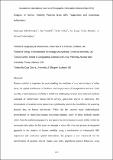Analysis of human mobility patterns from GPS trajectories and contextual information
Abstract
Human mobility is important for understanding the evolution of size and structure of urban areas, the spatial distribution of facilities, and the provision of transportation services. Until recently, exploring human mobility in detail was challenging because data collection methods consisted of cumbersome manual travel surveys, space-time diaries or interviews. The development of location-aware sensors has significantly altered the possibilities for acquiring detailed data on human movements. While this has spurred many methodological developments in identifying human movement patterns, many of these methods operate solely from the analytical perspective and ignore the environmental context within which the movement takes place. In this paper we attempt to widen this view and present an integrated approach to the analysis of human mobility using a combination of volunteered GPS trajectories and contextual spatial information. We propose a new framework for the identification of dynamic (travel modes) and static (significant places) behaviour using trajectory segmentation, data mining and spatio-temporal analysis. We are interested in examining if and how travel modes depend on the residential location, age or gender of the tracked individuals. Further, we explore theorised “third places”, which are spaces beyond main locations (home/work) where individuals spend time to socialise. Can these places be identified from GPS traces? We evaluate our framework using a collection of trajectories from 205 volunteers linked to contextual spatial information on the types of places visited and the transport routes they use. The result of this study is a contextually enriched data set that supports new possibilities for modelling human movement behaviour.
Citation
Sila-Nowicka , K , Vandrol , J , Oshan , T M , Long , J , Demsar , U & Fotheringham , S 2016 , ' Analysis of human mobility patterns from GPS trajectories and contextual information ' , International Journal of Geographical Information Science , vol. 30 , no. 5 , pp. 881-906 . https://doi.org/10.1080/13658816.2015.1100731
Publication
International Journal of Geographical Information Science
Status
Peer reviewed
ISSN
1365-8816Type
Journal article
Description
This work was supported by the EU FP7 Marie Curie ITN GEOCROWD grant (FP7- PEOPLE-2010-ITN-264994).Collections
Items in the St Andrews Research Repository are protected by copyright, with all rights reserved, unless otherwise indicated.

